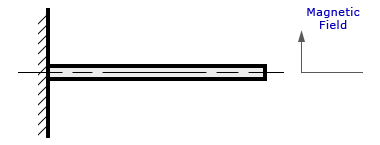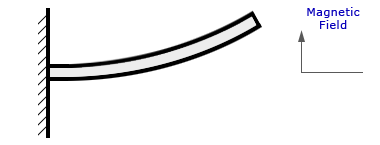Now let’s consider our magnet. If the magnet were more elastic, after we removed the reverse magnetizing force Hc, the magnet would return to its original state. However, if the magnet was more plastic, when Hc is removed, the magnet would not recover. The magnet that is elastic would need a greater force to cause it not to recover. This force in our mechanical model was F2. In the magnet this is called the “intrinsic coercivity”, Hci, sometimes written as iHc.
If we called the force that causes the cantilever to stay at the horizontal position after the removal of that force F2, then when the cantilever is very plastic, F1 would be equal to, or very close to F2. Similarly if the cantilever is very elastic, F2 would be larger than F1.
In a magnet, materials such as Alnico 5 have their F1 and F2 values (Hc and Hci) very close to each other. The same reverse magnetizing force that causes the magnets net effect to be zero is about the same magnetizing force that permanently demagnetizes the magnet. Materials such as Neodymium Iron Boron with high intrinsic coercivities such as N3275 have large differences between the F1 and F2 forces (Hc and Hci). To permanently demagnetize these magnets requires a lot more force than that required to make the net effect of the magnet zero.
Another interesting point that can be seen from this model is that the intrinsic coercivity, Hci, value of a permanent magnet can NEVER be less than its coercivity, Hc, value.
You may have already guessed by now that it is desirable to have the Hci value as high as possible. An infinite Hci would mean that the magnet is truly “permanent”. This is why the Hci values are always given as a minimum. There is no advantage for the Hci value to have an upper limit unless a failure of the magnet is a designed requirement.
Having a high Hci does not affect the magnets performance in any other way other than giving it permanence. If a magnet design worked when the magnet had an Hci = 17 kilo-Oersteds (17 kOe), a magnet with an Hci of 35 kOe would work the same way, except, it would be more permanent.
The intrinsic coercivity, Hci, not only allows the magnet to withstand a demagnetizing field, but also provides stability under other adverse circumstances such as being less susceptible to demagnetization at elevated temperatures, demagnetizing due to vibration, and demagnetizing due to exposure to radiation.
Drawings that specify the coercivity and intrinsic coercivity must only specify the minimums and not maximums. Another interesting note – the coercivity, Hc, value of a magnet can never exceed the residual induction value, Br.


